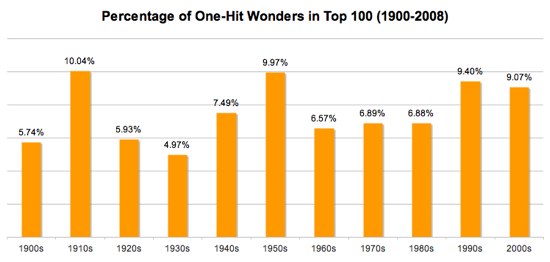
Andy Baio dove into the Whitburn Project data and came up with some interesting facts about one-hit wonders.
For the last ten years, obsessive record collectors in Usenet have been working on the Whitburn Project — a huge undertaking to preserve and share high-quality recordings of every popular song since the 1890s. To assist their efforts, they've created a spreadsheet of 37,000 songs and 112 columns of raw data, including each song's duration, beats-per-minute, songwriters, label, and week-by-week chart position.
Although we always associate the 1950s as the decade of one-hit wonders, this analysis shows that we're actually living in an era of the one-hit wonder as significant as the 50s. Almost 10% of the artists you'll find in the top 100 will never be there again.
Baio closes with a few facts about one-hit wonders that I found interesting. The longest-charting one-hit wonder to hit the #1 spot is Canadian Daniel Powter's "Bad Day" from 2006, which stayed on the charts for 32 weeks. And here's one that hits even closer to home. The longest-charting one-hit wonder to appear anywhere in the Top 100 is Duncan Sheik's "Barely Breathing" from 1997, which peaked at #16 but stayed in the top 100 for 55 weeks. Yes, Duncan Sheik, the very same Duncan who played the slide guitar on Custom's "May 26", which you'll find in the note Custom wrote to me and I shared on Wednesday.
See how it all ties together?







